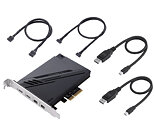Sunday, February 28th 2021

ASUS Rolls Out ThunderboltEX 4 Add-on Card
ASUS today rolled out the ThunderboltEX 4, an add-on card designed to give your PC full Thunderbolt 4 connectivity. The only catch here is that you'll need an ASUS motherboard with a Thunderbolt readiness header (which provides timing and other low-level system commands to the card). Also needed is a USB 2.0 header, of which you're likely to have plenty. The card features a PCI-Express 3.0 x4 host interface, and can be installed on any PCIe slot, x4 or larger. A 6-pin PCIe power input is also needed, as Thunderbolt 4 is capable of up to 100 W of power delivery per port, enabling single-cable RAID enclosures and monitors.
The ASUS ThunderboltEX 4 card puts out two Thunderbolt 4 ports in the USB type-C physical format, each with 40 Gbps of bi-directional bandwidth. The card provides DisplayPort passthrough for each port. You connect your graphics card to the ThunderboltEX 4 using the included DisplayPort to mini-DisplayPort cables. The card supports DisplayPort 1.4 passthrough, so you can scale all the way up to 8K resolution on the connected monitors, if your graphics card is game. Under the hood, the card features an Intel JHL8540 "Maple Ridge" Thunderbolt 4 controller. The company didn't reveal pricing.
The ASUS ThunderboltEX 4 card puts out two Thunderbolt 4 ports in the USB type-C physical format, each with 40 Gbps of bi-directional bandwidth. The card provides DisplayPort passthrough for each port. You connect your graphics card to the ThunderboltEX 4 using the included DisplayPort to mini-DisplayPort cables. The card supports DisplayPort 1.4 passthrough, so you can scale all the way up to 8K resolution on the connected monitors, if your graphics card is game. Under the hood, the card features an Intel JHL8540 "Maple Ridge" Thunderbolt 4 controller. The company didn't reveal pricing.





6 Comments on ASUS Rolls Out ThunderboltEX 4 Add-on Card
At least I guess it won't look messy outside the case if you don't need the display signal over TB...
Technically the USB 2.0 cable isn't needed as well, as it's only required if you want to use USB 2.0 peripherals over something connected to the TB ports.
Bit and Bytes are differentusb 2.0 is needed because 3.0 4x slot only achive 3940MB/s. Usb 2.0 and specific thenderboltex 4 header on motherboard they achive 40gbps = 5gb/s speed
However, considering what is required to reach 40 Gbps on a port anyway (either a 0.8m max passive cable or a 2m max active cable), many people will be limited at 20 Gb/s by their cables (passive > 0.8m). So having 2 ports at 20 Gb/s is a viable scenario.